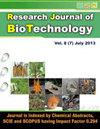藻溶性弧菌 ATCC 17749 基因组中推测的溶血蛋白的硅学分析及其结构预测
IF 0.2
Q4 Biochemistry, Genetics and Molecular Biology
引用次数: 0
摘要
溶血素是病原菌的主要致病因子之一。溶血素能分解红细胞(RBC),这就是所谓的溶血。溶血素作用于红细胞的细胞膜,导致膜上形成孔隙,并将血红蛋白释放到生长环境中。血红蛋白在嗜苷酸盐的帮助下被病原菌用作铁源,或通过细菌细胞膜上的铁受体吸收。尽管溶血素或细胞溶解素能在红细胞内形成孔隙,但也能在肥大细胞、中性粒细胞和多形核细胞等多种细胞内形成孔隙。它还能造成组织和细胞损伤,从而增强毒力。溶血素与引起伤口感染或肠道感染的不同弧菌属的致病机理有关。众所周知,霍乱弧菌和副溶血性弧菌会引起肠道感染,而藻溶弧菌和弧菌则会引起伤口感染。对藻类溶解弧菌 ATCC 17749 的基因组进行了分析,以确定负责溶血素生物合成的基因。它的基因组编码五种溶血素,这些溶血素可能在溶血和致病过程中发挥重要作用。生理特性功能注释和结构预测将大大提高人们对藻类溶血弧菌 ATCC 117749 溶血素的认识水平。本文章由计算机程序翻译,如有差异,请以英文原文为准。
In silico analysis of putative hemolysin proteins in the genome of Vibrio alginolyticus ATCC 17749 and their structure prediction
Hemolysin is one of the major pathogenic factors for pathogenic bacteria. Hemolysin can break down erythrocytes (RBC) which is called hemolysis. Hemolysins act on the cell membrane of erythrocytes, resulting in pore formation in the membrane and liberating hemoglobin into the growing environment. Hemoglobin is used as an iron source by pathogenic bacteria with the help of a siderophore or is taken up via iron receptors present on the bacterial cell membrane. Despite the pore formation into erythrocytes, hemolysin or cytolysin has also the ability to pore formation in a broad range of the cells such as mast cells, neutrophils and polymorphonuclear cells. It also enhances virulence by causing tissue and cell damage. Hemolysin is associated with the pathogenesis of different Vibrio spp. that cause either wound infection or intestinal infection. V. cholerae and V. parahemolyticus are popularly known for intestinal infection whereas V. alginolyticus and V. vulnificus cause would infections. The genome of Vibrio alginolyticus ATCC 17749 was analyzed for the gene responsible for the biosynthesis of hemolysins. Its genome encodes for five hemolysins that might play an important role in hemolysis and pathogenesis. Physiological properties functional annotation and predicted structure will significantly increase the level of understanding of hemolysins of Vibrio alginolyticus ATCC 117749.
求助全文
通过发布文献求助,成功后即可免费获取论文全文。
去求助
来源期刊

Research Journal of Biotechnology
工程技术-生物工程与应用微生物
CiteScore
0.60
自引率
0.00%
发文量
192
审稿时长
1.5 months
期刊介绍:
We invite you to contribute Research Papers / Short Communications / Review Papers:
-In any field of Biotechnology, Biochemistry, Microbiology and Industrial Microbiology, Soil Technology, Agriculture Biotechnology.
-in any field related to Food Biotechnology, Nutrition Biotechnology, Genetic Engineering and Commercial Biotechnology.
-in any field of Biotechnology related to Drugs and Pharmaceutical products for human beings, animals and plants.
-in any field related to Environmental Biotechnolgy, Waste Treatment of Liquids, Soilds and Gases; Sustainability.
-in inter-realted field of Chemical Sciences, Biological Sciences, Environmental Sciences and Life Sciences.
-in any field related to Biotechnological Engineering, Industrial Biotechnology and Instrumentation.
-in any field related to Nano-technology.
-in any field related to Plant Biotechnology.
 求助内容:
求助内容: 应助结果提醒方式:
应助结果提醒方式:


